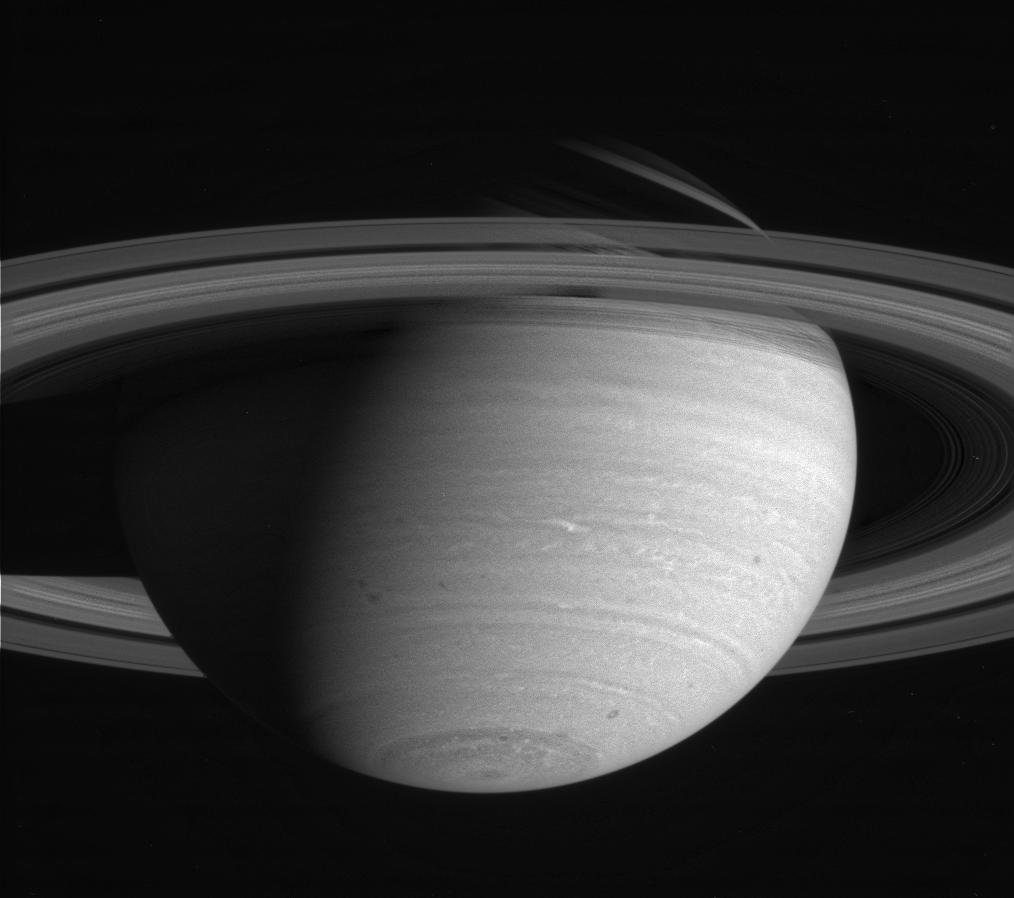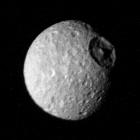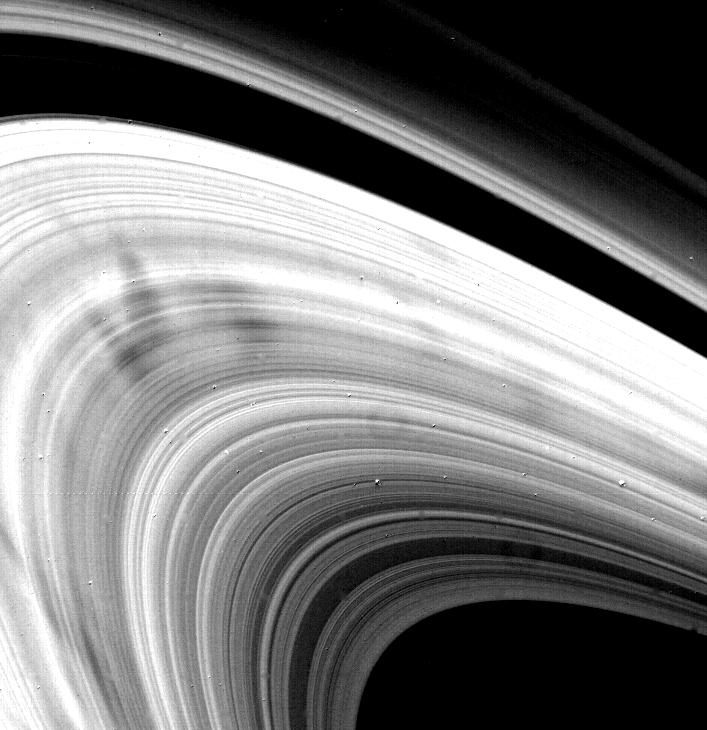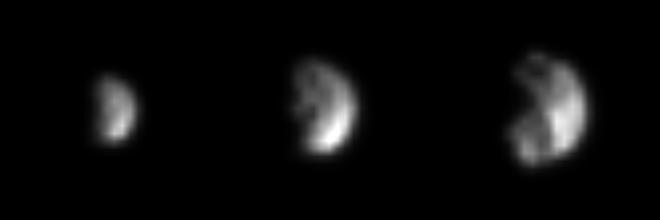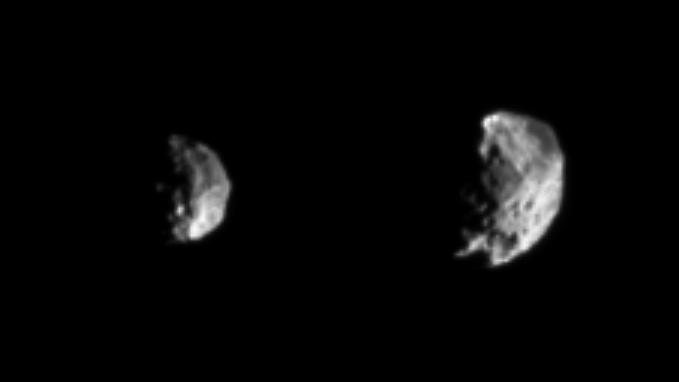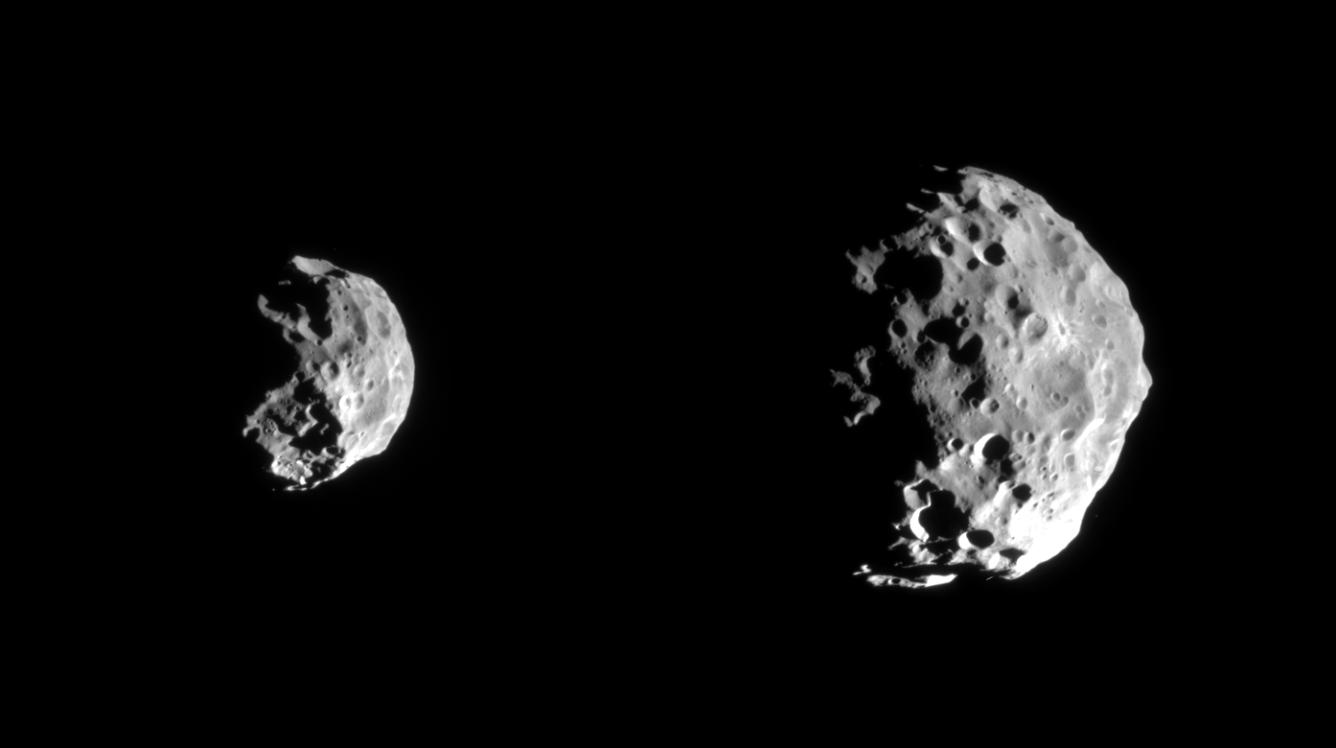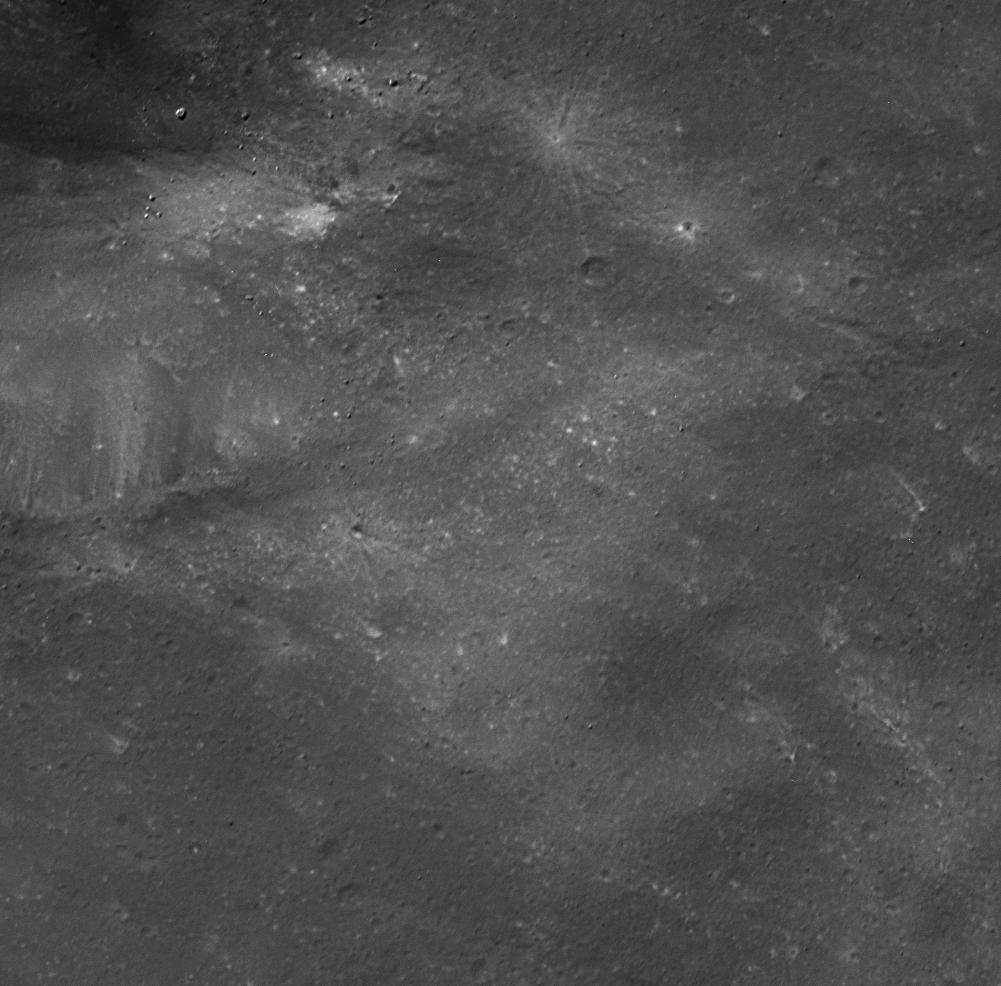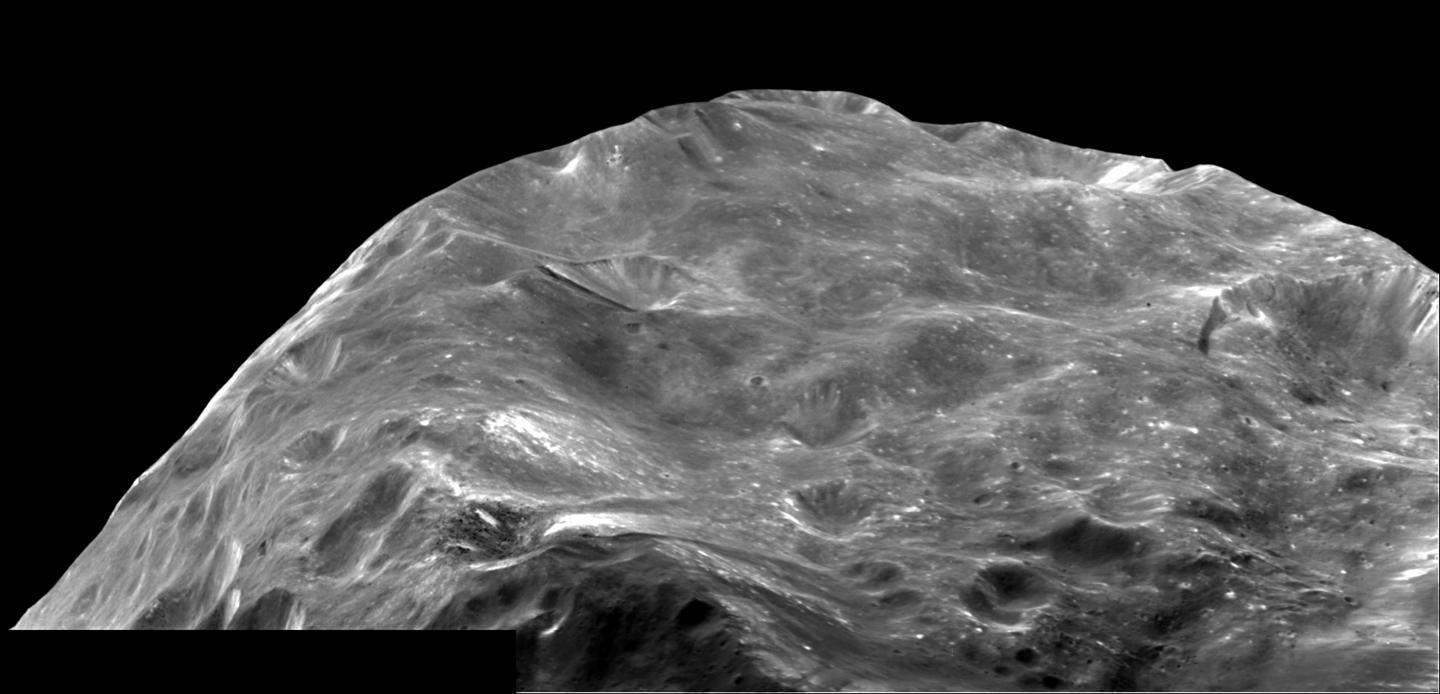WFL Wetenschap, Filosofie, Levensbeschouwing
Discussieer hier over alle aspecten van de wetenschap, filosofische problemen en zaken van levensbeschouwelijke aard.



Zij bevinden zich natuurlijk niet allemaal op dezelfde afstand van Saturnus. Overigens moet je niet vergeten dat de ringen van Saturnus vol met andere natuurlijke satelieten zitten. Dat vergeet men nog wel eens, dat het immers net zoals die manen ook satalieten zijnquote:Op woensdag 2 juni 2004 03:40 schreef boomstamp het volgende:
botsen die 21 manen niet opelkaar dan?


quote:Op woensdag 2 juni 2004 04:16 schreef k3vil het volgende:
[..]
Zij bevinden zich natuurlijk niet allemaal op dezelfde afstand van Saturnus. Overigens moet je niet vergeten dat de ringen van Saturnus vol met andere natuurlijke satelieten zitten. Dat vergeet men nog wel eens, dat het immers net zoals die manen ook satalieten zijn
alstublieft
"Mijn" fotoalbum...
-->creationisme _O- --> http://en.wikipedia.org/wiki/Panspermia *O* evolutie & Darwin O+
-->


quote:Op donderdag 27 mei 2004 20:05 schreef Pinobot het volgende:
Kicke, Mimas lijkt op de Deathstar.
bron
"Mijn" fotoalbum...
-->creationisme _O- --> http://en.wikipedia.org/wiki/Panspermia *O* evolutie & Darwin O+
-->


Atmospheric Detail in the Near Infrared
June 2, 2004
Saturn shows white feathery clouds near 45 degrees south latitude.
Note the disturbances around the eastern edge of the south polar collar.
The moon Mimas is visible above the rings at the upper right.
The image was taken with the Cassini narrow angle camera in the
near infrared on May 10, 2004, at a distance of 27.2 million kilometers
(16.9 million miles) from Saturn.
Image scale is 162 kilometers (101 miles) per pixel. Contrast in the image
was enhanced to aid visibility.
The conspicuous crater on the surface of Saturn's moon Mimas is seen in this image taken by Voyager.
The massive crater, whose
proportionate size (approximately 100 kilometers or 60 miles) is about
one-quarter of the satellite's diameter (390 kilometers or 235 miles),
is without precedent among the explored objects of the solar system.
The impact that formed the crater was probably almost large enough
to shatter Mimas into two or more fragments.
[ Bericht 29% gewijzigd door -CRASH- op 02-06-2004 21:55:03 ]
June 2, 2004
Saturn shows white feathery clouds near 45 degrees south latitude.
Note the disturbances around the eastern edge of the south polar collar.
The moon Mimas is visible above the rings at the upper right.
The image was taken with the Cassini narrow angle camera in the
near infrared on May 10, 2004, at a distance of 27.2 million kilometers
(16.9 million miles) from Saturn.
Image scale is 162 kilometers (101 miles) per pixel. Contrast in the image
was enhanced to aid visibility.
The conspicuous crater on the surface of Saturn's moon Mimas is seen in this image taken by Voyager.
The massive crater, whose
proportionate size (approximately 100 kilometers or 60 miles) is about
one-quarter of the satellite's diameter (390 kilometers or 235 miles),
is without precedent among the explored objects of the solar system.
The impact that formed the crater was probably almost large enough
to shatter Mimas into two or more fragments.
[ Bericht 29% gewijzigd door -CRASH- op 02-06-2004 21:55:03 ]
<a href="http://www.vwkweb.nl/" rel="nofollow" target="_blank">Vereniging voor weerkunde en klimatologie</a>
<a href="http://www.estofex.org/" rel="nofollow" target="_blank">ESTOFEX</a>
<a href="http://www.estofex.org/" rel="nofollow" target="_blank">ESTOFEX</a>


Ja, het worden spannende maanden voor de ruimtevaart!
Ik ben echt benieuwd naar de beelden van Titan...
Ik ben echt benieuwd naar de beelden van Titan...
Ars longa, vita brevis


Ik hou niet van voetbal ( dat woordt al)quote:Op woensdag 2 juni 2004 23:21 schreef motown het volgende:
Ja, het worden spannende maanden voor de ruimtevaart!
Ik ben echt benieuwd naar de beelden van Titan...
Titan heeft een Oranje kleur en Huygens is een Nederlander
Titan
<a href="http://www.vwkweb.nl/" rel="nofollow" target="_blank">Vereniging voor weerkunde en klimatologie</a>
<a href="http://www.estofex.org/" rel="nofollow" target="_blank">ESTOFEX</a>
<a href="http://www.estofex.org/" rel="nofollow" target="_blank">ESTOFEX</a>


Passage through the Ring Plane
June 3, 2004
The path that lies ahead for the Cassini-Huygens mission is indicated in this image
which illustrates where the spacecraft will be just 27 days from now, when it
arrives at Saturn and crosses the ring plane 33 minutes before performing its
critical orbital insertion maneuver.
The X indicates the point where Cassini will pierce the ring plane on June 30, 2004,
going from south to north of the ring plane, 33 minutes before the main engine fires
to begin orbital insertion. The indicated point is between the narrow F-ring on the left
and Saturn's tenuous G-ring which is too faint to be seen in this exposure.
The image was taken on May 11, 2004 when the spacecraft was 26.3 million kilometers
(16.3 million miles) from Saturn. Image scale is 158 kilometers (98 miles) per pixel.
Moons visible in this image: Janus (181 kilometers or 113 miles across), one of the
co-orbital moons; Pandora (84 kilometers or 52 miles across), one of the F ring
shepherding moons; and Enceladus (499 kilometers or 310 miles across), a moon
which may be heated from within and thus have a liquid sub-surface ocean.
June 3, 2004
The path that lies ahead for the Cassini-Huygens mission is indicated in this image
which illustrates where the spacecraft will be just 27 days from now, when it
arrives at Saturn and crosses the ring plane 33 minutes before performing its
critical orbital insertion maneuver.
The X indicates the point where Cassini will pierce the ring plane on June 30, 2004,
going from south to north of the ring plane, 33 minutes before the main engine fires
to begin orbital insertion. The indicated point is between the narrow F-ring on the left
and Saturn's tenuous G-ring which is too faint to be seen in this exposure.
The image was taken on May 11, 2004 when the spacecraft was 26.3 million kilometers
(16.3 million miles) from Saturn. Image scale is 158 kilometers (98 miles) per pixel.
Moons visible in this image: Janus (181 kilometers or 113 miles across), one of the
co-orbital moons; Pandora (84 kilometers or 52 miles across), one of the F ring
shepherding moons; and Enceladus (499 kilometers or 310 miles across), a moon
which may be heated from within and thus have a liquid sub-surface ocean.
<a href="http://www.vwkweb.nl/" rel="nofollow" target="_blank">Vereniging voor weerkunde en klimatologie</a>
<a href="http://www.estofex.org/" rel="nofollow" target="_blank">ESTOFEX</a>
<a href="http://www.estofex.org/" rel="nofollow" target="_blank">ESTOFEX</a>


De pers briefing is geweest en hier zijn de links met d voledige info...
webcast met stream van filmpjes (staan ook op de nasa site onder media (meestal groter!)...)
press kit cassini project
en natuurlijk de press release!
-quotes uit het document komen later vandaag nog -
webcast met stream van filmpjes (staan ook op de nasa site onder media (meestal groter!)...)
press kit cassini project
en natuurlijk de press release!
-quotes uit het document komen later vandaag nog -
"Mijn" fotoalbum...
-->creationisme _O- --> http://en.wikipedia.org/wiki/Panspermia *O* evolutie & Darwin O+
-->


Verdomd...... dat is wazig zeg!quote:Op woensdag 2 juni 2004 11:04 schreef Marvin-THE-MARTiAN het volgende:
[..]
[afbeelding]
bron
[afbeelding]
[afbeelding]
Ik hoop dat alles goed gaat met de orbit insertion burn etc. Het zou flink balen zijn als na 7 jaar in de ruimte blijkt dat er iets niet goed werkt. De laatste grote sonde voordat de NASA aan hun 'smaller, better, faster, cheaper' programma begon (wat tot nog toe maar matig succes heeft).


Jij kent je klassiekers zeker niet? Janus the two-faced god?quote:Op vrijdag 4 juni 2004 18:20 schreef k3vil het volgende:
Een maan die Janus heet


hmmm mischien moeten we eens een cd'tje gaan uitbrengen met ruimte muziek
Music2Titan
beginnende met CD1&2 van de Marsrovers (Opportunity &Spirit) welke ellke ochtend wakker worden met een nummer. En CD3 de Golden record welke met voyager omhoog ging en afsluiten met CD4 met alle hits die vanaf nu naar boven gaan waaronder deze naar Titan dus...
Music2Titan
beginnende met CD1&2 van de Marsrovers (Opportunity &Spirit) welke ellke ochtend wakker worden met een nummer. En CD3 de Golden record welke met voyager omhoog ging en afsluiten met CD4 met alle hits die vanaf nu naar boven gaan waaronder deze naar Titan dus...
"Mijn" fotoalbum...
-->creationisme _O- --> http://en.wikipedia.org/wiki/Panspermia *O* evolutie & Darwin O+
-->


Blijkbaar niet, maar nu heb je er wel aanleiding voor gegevenquote:Op zaterdag 5 juni 2004 10:16 schreef JeroenH het volgende:
[..]
Jij kent je klassiekers zeker niet? Janus the two-faced god?


Prometheus and Knots in the F Ring
June 7, 2004
Saturn's moon Prometheus is seen orbiting inside the planet's F-ring,
which exhibits some of the knotted structure for which it is renowned.
Near the center, separating the A and B rings is the famous Cassini division.
The image was taken with the Cassini narrow angle camera on May 10, 2004,
at a distance of 27 million kilometers (16.8 million miles) from Saturn.
Image scale is 161 kilometers (100 miles) per pixel. Prometheus is 102 kilometers (63 miles) across.
The image has been contrast-enhanced and magnified to aid visibility.
June 7, 2004
Saturn's moon Prometheus is seen orbiting inside the planet's F-ring,
which exhibits some of the knotted structure for which it is renowned.
Near the center, separating the A and B rings is the famous Cassini division.
The image was taken with the Cassini narrow angle camera on May 10, 2004,
at a distance of 27 million kilometers (16.8 million miles) from Saturn.
Image scale is 161 kilometers (100 miles) per pixel. Prometheus is 102 kilometers (63 miles) across.
The image has been contrast-enhanced and magnified to aid visibility.
<a href="http://www.vwkweb.nl/" rel="nofollow" target="_blank">Vereniging voor weerkunde en klimatologie</a>
<a href="http://www.estofex.org/" rel="nofollow" target="_blank">ESTOFEX</a>
<a href="http://www.estofex.org/" rel="nofollow" target="_blank">ESTOFEX</a>


De ringen onder je ogen...quote:Op dinsdag 8 juni 2004 00:13 schreef k3vil het volgende:
Ik vind dat nog steeds echt een fenomeen die ringen.
[ontopic]
Ja de ringen hebben nog veel geheimen.
Zoals de "spokes" die Voyager 2 gefotografeerd heeft.
<a href="http://www.vwkweb.nl/" rel="nofollow" target="_blank">Vereniging voor weerkunde en klimatologie</a>
<a href="http://www.estofex.org/" rel="nofollow" target="_blank">ESTOFEX</a>
<a href="http://www.estofex.org/" rel="nofollow" target="_blank">ESTOFEX</a>


Closing in on Phoebe
June 9, 2004
The Cassini spacecraft is closing in fast on its first target of observation
in the Saturn system: the small, mysterious moon Phoebe,
only 220 kilometers (137 miles) across.
The three images shown here, the latest of which is twice as good as
any image returned by the Voyager 2 spacecraft in 1981,
were captured in the past week on approach to this outer moon of Saturn.
Phoebe's surface is already showing a great deal of contrast,
most likely indicative of topography, such as tall sunlit peaks and deep shadowy craters,
as well as genuine variation in the reflectivity of its surface materials.
Left to right, the three views were captured at a phase (Sun-Saturn-spacecraft) angle of
87 degrees between June 4 and June 7, from distances ranging from
4.1 million kilometers (2.6 million miles) to 2.5 million kilometers (1.5 million miles).
The image scale ranges from 25 to 15 kilometers per pixel.
Phoebe rotates once every nine hours and 16 minutes;
each of these images shows a different region on Phoebe.
Phoebe was the discovered in 1898. It has a very dark surface.
June 9, 2004
The Cassini spacecraft is closing in fast on its first target of observation
in the Saturn system: the small, mysterious moon Phoebe,
only 220 kilometers (137 miles) across.
The three images shown here, the latest of which is twice as good as
any image returned by the Voyager 2 spacecraft in 1981,
were captured in the past week on approach to this outer moon of Saturn.
Phoebe's surface is already showing a great deal of contrast,
most likely indicative of topography, such as tall sunlit peaks and deep shadowy craters,
as well as genuine variation in the reflectivity of its surface materials.
Left to right, the three views were captured at a phase (Sun-Saturn-spacecraft) angle of
87 degrees between June 4 and June 7, from distances ranging from
4.1 million kilometers (2.6 million miles) to 2.5 million kilometers (1.5 million miles).
The image scale ranges from 25 to 15 kilometers per pixel.
Phoebe rotates once every nine hours and 16 minutes;
each of these images shows a different region on Phoebe.
Phoebe was the discovered in 1898. It has a very dark surface.
<a href="http://www.vwkweb.nl/" rel="nofollow" target="_blank">Vereniging voor weerkunde en klimatologie</a>
<a href="http://www.estofex.org/" rel="nofollow" target="_blank">ESTOFEX</a>
<a href="http://www.estofex.org/" rel="nofollow" target="_blank">ESTOFEX</a>


Mischien een hele stomme vraag hoor, maar waarom bv geen kleuren plaatjes van saturnus, of heeft dat te maken met dat het langer duurt om te versturen naar de aarde, ivm de groote ?
Not that we needed all that for the trip, but once you get into a serious drug collection, the tendency is to push it as far as you can.


Voor navigatie doeleinden zijn geen kleuren foto's nodig.quote:Op donderdag 10 juni 2004 11:17 schreef Mighty_Mike het volgende:
Mischien een hele stomme vraag hoor, maar waarom bv geen kleuren plaatjes van saturnus, of heeft dat te maken met dat het langer duurt om te versturen naar de aarde, ivm de groote ?
Maar af en toe worden er toch kleuren foto's gemaakt
kijk maar eens op de foto site
<a href="http://www.vwkweb.nl/" rel="nofollow" target="_blank">Vereniging voor weerkunde en klimatologie</a>
<a href="http://www.estofex.org/" rel="nofollow" target="_blank">ESTOFEX</a>
<a href="http://www.estofex.org/" rel="nofollow" target="_blank">ESTOFEX</a>


Countdown to Phoebe
June 10, 2004
As Cassini sails toward its rendezvous with Phoebe, details on the small, dark moon are coming into view at a dizzying pace. The images shown here were taken 13 hours apart on June 10, 2004, just one day prior to closest approach. There is a dramatic increase in detail between these two views. Phoebe completes one rotation about its spin axis in nine hours and 16 minutes. We are looking at opposite hemispheres in these two views.
A large crater, roughly 50 kilometers (31 miles) across, is visible in the image on the left. The image on the right shows a body heavily pitted with craters of varying sizes, including very large ones, and displaying a substantial amount of variation in surface brightness. Features that appear to be cliffs may be the boundaries between large craters. Despite its exaggerated topography, Phoebe is more round than irregular in shape.
Left to right, the two views were obtained at a phase, or Sun-Phoebe spacecraft angle, of 87 degrees, and from distances of 956,000 kilometers (594,000 miles) and 658,000 kilometers (409,000 miles), respectively. The image resolutions are 5.7 and 3.9 kilometers (3.5 to 2.4 miles) per pixel, respectively. To aid visibility, the images were magnified three times via linear interpolation; no contrast enhancement was performed.
Phoebe is approximately 220 kilometers (137 miles) wide. On Phoebe, the spin axis points up and approximately 13 degrees to the left of the boundary between day and night. Cassini draws closer to its only flyby of this mysterious outer moon of Saturn. Closest approach to Phoebe will be at 1:56 p.m. Pacific Time on June 11.
June 10, 2004
As Cassini sails toward its rendezvous with Phoebe, details on the small, dark moon are coming into view at a dizzying pace. The images shown here were taken 13 hours apart on June 10, 2004, just one day prior to closest approach. There is a dramatic increase in detail between these two views. Phoebe completes one rotation about its spin axis in nine hours and 16 minutes. We are looking at opposite hemispheres in these two views.
A large crater, roughly 50 kilometers (31 miles) across, is visible in the image on the left. The image on the right shows a body heavily pitted with craters of varying sizes, including very large ones, and displaying a substantial amount of variation in surface brightness. Features that appear to be cliffs may be the boundaries between large craters. Despite its exaggerated topography, Phoebe is more round than irregular in shape.
Left to right, the two views were obtained at a phase, or Sun-Phoebe spacecraft angle, of 87 degrees, and from distances of 956,000 kilometers (594,000 miles) and 658,000 kilometers (409,000 miles), respectively. The image resolutions are 5.7 and 3.9 kilometers (3.5 to 2.4 miles) per pixel, respectively. To aid visibility, the images were magnified three times via linear interpolation; no contrast enhancement was performed.
Phoebe is approximately 220 kilometers (137 miles) wide. On Phoebe, the spin axis points up and approximately 13 degrees to the left of the boundary between day and night. Cassini draws closer to its only flyby of this mysterious outer moon of Saturn. Closest approach to Phoebe will be at 1:56 p.m. Pacific Time on June 11.
<a href="http://www.vwkweb.nl/" rel="nofollow" target="_blank">Vereniging voor weerkunde en klimatologie</a>
<a href="http://www.estofex.org/" rel="nofollow" target="_blank">ESTOFEX</a>
<a href="http://www.estofex.org/" rel="nofollow" target="_blank">ESTOFEX</a>


Battered Moon
June 12, 2004
Early images returned from the first detailed reconnaissance of Saturn's small outer moon, Phoebe, show breathtaking details in the moon's pockmarked surface that already have imaging scientists puzzling over the body's history. The images are only a preview of what to expect from the high resolution images to be examined later today which will show details about 10 times smaller.
Phoebe has revealed itself to be a rugged, heavily cratered body, with overlapping craters of varying sizes. This morphology suggests an old surface. There are apparently many craters smaller than 1 km, indicating that projectiles probably smaller than 100 meters once pummeled Phoebe. Whether these objects were cometary or asteroidal in origin, or were the debris that resulted from impacts on other bodies within the Saturn system, is hotly debated. There is also variation in surface brightness across the body.
In the first image (at left) in which Phoebe looks somewhat like a sideways skull, the large crater near the bottom displays a complex and rugged interior. The lower right hand part of Phoebe appears to be covered by bright wispy material.
The second, higher resolution image further reveals the moon's battered surface, including a crater near the right hand edge with bright rays that extend outward from its center. This suggests that dark material coats the outside. Features reminiscent of those seen on the Martian moon Phobos -- such as linear grooves--are faintly visible in the upper part of this image. There are suggestions of linear ridges or grooves and of chains of craters, perhaps radial to a large crater just hidden on the un-illuminated region in the upper left.
Left to right, the two views were obtained at phase, or Sun-Phoebe-spacecraft, angles of approximately 86 degrees, and from distances ranging from 143,068 kilometers (88,918 miles) to 77,441 kilometers (48, 130 miles); for reference, Cassini's closest approach to Phoebe was approximately 2,068 kilometers (1,285 miles). The image scale ranges from 0.86 to 0.46 kilometers (0.53 to 0.29 miles) per pixel. No enhancement of any kind has been performed on the images.
June 12, 2004
Early images returned from the first detailed reconnaissance of Saturn's small outer moon, Phoebe, show breathtaking details in the moon's pockmarked surface that already have imaging scientists puzzling over the body's history. The images are only a preview of what to expect from the high resolution images to be examined later today which will show details about 10 times smaller.
Phoebe has revealed itself to be a rugged, heavily cratered body, with overlapping craters of varying sizes. This morphology suggests an old surface. There are apparently many craters smaller than 1 km, indicating that projectiles probably smaller than 100 meters once pummeled Phoebe. Whether these objects were cometary or asteroidal in origin, or were the debris that resulted from impacts on other bodies within the Saturn system, is hotly debated. There is also variation in surface brightness across the body.
In the first image (at left) in which Phoebe looks somewhat like a sideways skull, the large crater near the bottom displays a complex and rugged interior. The lower right hand part of Phoebe appears to be covered by bright wispy material.
The second, higher resolution image further reveals the moon's battered surface, including a crater near the right hand edge with bright rays that extend outward from its center. This suggests that dark material coats the outside. Features reminiscent of those seen on the Martian moon Phobos -- such as linear grooves--are faintly visible in the upper part of this image. There are suggestions of linear ridges or grooves and of chains of craters, perhaps radial to a large crater just hidden on the un-illuminated region in the upper left.
Left to right, the two views were obtained at phase, or Sun-Phoebe-spacecraft, angles of approximately 86 degrees, and from distances ranging from 143,068 kilometers (88,918 miles) to 77,441 kilometers (48, 130 miles); for reference, Cassini's closest approach to Phoebe was approximately 2,068 kilometers (1,285 miles). The image scale ranges from 0.86 to 0.46 kilometers (0.53 to 0.29 miles) per pixel. No enhancement of any kind has been performed on the images.
<a href="http://www.vwkweb.nl/" rel="nofollow" target="_blank">Vereniging voor weerkunde en klimatologie</a>
<a href="http://www.estofex.org/" rel="nofollow" target="_blank">ESTOFEX</a>
<a href="http://www.estofex.org/" rel="nofollow" target="_blank">ESTOFEX</a>


"Mijn" fotoalbum...
-->creationisme _O- --> http://en.wikipedia.org/wiki/Panspermia *O* evolutie & Darwin O+
-->


quote:
En nog meer
Die rotsblokken in de krater
[ Bericht 12% gewijzigd door -CRASH- op 14-06-2004 23:33:47 ]
<a href="http://www.vwkweb.nl/" rel="nofollow" target="_blank">Vereniging voor weerkunde en klimatologie</a>
<a href="http://www.estofex.org/" rel="nofollow" target="_blank">ESTOFEX</a>
<a href="http://www.estofex.org/" rel="nofollow" target="_blank">ESTOFEX</a>





